
Creator of the award-winning web series, Abnormal Fixation. One of the horror genre's "most widely read critics" (Rue Morgue # 68), "an accomplished film journalist" (Comic Buyer's Guide #1535), and the award-winning author of Horror Films of the 1980s (2007) and Horror Films of the 1970s (2002), John Kenneth Muir, presents his blog on film, television and nostalgia, named one of the Top 100 Film Studies Blog on the Net.
Tuesday, February 28, 2006
Guess the Movie # 5

 award-winning creator of the web series Abnormal Fixation (2024), the audio drama Enter the House Between (2023) and author of 35 books including Horror Films FAQ (2013), Horror Films of the 1990s (2011), Horror Films of the 1980s (2007), TV Year (2007), The Rock and Roll Film Encyclopedia (2007), Mercy in Her Eyes: The Films of Mira Nair (2006),, Best in Show: The Films of Christopher Guest and Company (2004), The Unseen Force: The Films of Sam Raimi (2004), An Askew View: The Films of Kevin Smith (2002), The Encyclopedia of Superheroes on Film & Television (2004), Exploring Space:1999 (1997), An Analytical Guide to TV's Battlestar Galactica (1998), Terror Television (2001), Space:1999 - The Forsaken (2003) and Horror Films of the 1970s (2002).
award-winning creator of the web series Abnormal Fixation (2024), the audio drama Enter the House Between (2023) and author of 35 books including Horror Films FAQ (2013), Horror Films of the 1990s (2011), Horror Films of the 1980s (2007), TV Year (2007), The Rock and Roll Film Encyclopedia (2007), Mercy in Her Eyes: The Films of Mira Nair (2006),, Best in Show: The Films of Christopher Guest and Company (2004), The Unseen Force: The Films of Sam Raimi (2004), An Askew View: The Films of Kevin Smith (2002), The Encyclopedia of Superheroes on Film & Television (2004), Exploring Space:1999 (1997), An Analytical Guide to TV's Battlestar Galactica (1998), Terror Television (2001), Space:1999 - The Forsaken (2003) and Horror Films of the 1970s (2002).
TV REVIEW: Deal or No Deal
This high-powered, slick game show airing on NBC turned out to be a big surprise hit the last time it aired (racking up something on the order of 50 million viewers...), so I figured that last night I ought to check out Deal or No Deal for myself.
Every few years, network TV experiences a "game show" craze. Back in 2000 and 2001, this craze brought us Who Wants to Be A Millionaire (every...bloody...night...of...the... week), as well as The Weakest Link. I guess the cycle's coming around again, and my initial perception about Deal or No Deal (before watching the show...) was that the title sounded like a synonym for the Monty Hall classic, Let's Make a Deal. No?
Turns out the comparison isn't particularly apt. Let's Make a Deal featured colorful guests in crazy costumes enthusiastically guessing about the prizes hidden behind numbered doors. Deal or No Deal is a different animal all together. Reflecting our times, it's a serious, no-frills business that feels more like a meeting with mortgage lenders or some other pressure-cooker, rather than genuine fun. Everybody looks great - the set is multi-story, opulently lit, and displays the wealth of American culture. The game play is basic and stream-lined, and the stress level of the contestants appears quite high, if last night's installment was any example.
The premise of the show is this: host Howie Mandel (sans hair...) invites up to a podium a new contestant. Last night, it was a Las Vegas S.W.A.T. officer. Anyway, to paraphrase Mr. Mandel, there are "no crazy stunts, no trivia, no skill" involved in the game, just an answer to the simple question "deal or no deal." In other words, this is a perfect game for the age of Paris Hilton. The contestants don't need to be intelligent, well-read or talented. They just have to show up and bear the pressure.
Anyway, to get the game started, twenty-six super sexy models who look like they just came off Robert Palmer's clone farm, descend onto a staircase holding 26 suitcases. In each suitcase is a denomination of money ranging from one penny to a million dollars. The contestant picks a briefcase, in hopes that it contains big money, and then has to watch - in torturous slow-motion and between commercial breaks - as he is asked to open up the other cases, a few at a time, to determine how much he wins.
Every now and then, a shadowy figure called "the banker" makes an offer from a dark booth above the stage, trying to play the odds and keep the contestant from winning too much money. In a bit of melodrama, he calls down to the stage and makes offers that the contestant can accept or reject. Hence a deal. Or no deal.
As matters get increasingly hairy, the contestant is allowed to bring a team of supporters on stage. And then, when things get really rough, an "expert" comes up for moral support and professional advice. Last night, that expert was Donald Trump, who first advised the police officer to "go for it," but when the money got up to $359,000.00 wisely admonished the contestant to "take the money." He did.
To keep the game interactive, Deal or No Deal also offers viewers a chance to win at home. They can win ten thousand dollars if they get up off the sofa and text message a "guess" about which of six briefcases contains the money.
I've watched game shows since I was a little kid (Anybody remember Whew!?), and they're occasionally diverting, especially if you're taking heavy flu medication. Honestly, I can't really commit to them on any long term basis. But word to the wise: if you want to get on any quiz show as a contestant, Deal or No Deal seems like the ideal choice since you won't have to study geography, science, history, sports and leisure, entertainment trivia or anything else beforehand.
Personally, I prefer Jeopardy. At least when Jeopardy's over, I've learned a thing or two about a thing or two, and don't feel like I've wasted an hour of my life. For me, that's the deal-breaker on Deal or No Deal. Having watched it once, I feel no need or burning desire to watch it again. My "offer" to NBC? They should play this thing out fast. Because people will tire of it quickly.
 award-winning creator of the web series Abnormal Fixation (2024), the audio drama Enter the House Between (2023) and author of 35 books including Horror Films FAQ (2013), Horror Films of the 1990s (2011), Horror Films of the 1980s (2007), TV Year (2007), The Rock and Roll Film Encyclopedia (2007), Mercy in Her Eyes: The Films of Mira Nair (2006),, Best in Show: The Films of Christopher Guest and Company (2004), The Unseen Force: The Films of Sam Raimi (2004), An Askew View: The Films of Kevin Smith (2002), The Encyclopedia of Superheroes on Film & Television (2004), Exploring Space:1999 (1997), An Analytical Guide to TV's Battlestar Galactica (1998), Terror Television (2001), Space:1999 - The Forsaken (2003) and Horror Films of the 1970s (2002).
award-winning creator of the web series Abnormal Fixation (2024), the audio drama Enter the House Between (2023) and author of 35 books including Horror Films FAQ (2013), Horror Films of the 1990s (2011), Horror Films of the 1980s (2007), TV Year (2007), The Rock and Roll Film Encyclopedia (2007), Mercy in Her Eyes: The Films of Mira Nair (2006),, Best in Show: The Films of Christopher Guest and Company (2004), The Unseen Force: The Films of Sam Raimi (2004), An Askew View: The Films of Kevin Smith (2002), The Encyclopedia of Superheroes on Film & Television (2004), Exploring Space:1999 (1997), An Analytical Guide to TV's Battlestar Galactica (1998), Terror Television (2001), Space:1999 - The Forsaken (2003) and Horror Films of the 1970s (2002).
TV REVIEW: Medium: "Sweet Child O'Mine"
Which is a shame, because this is a fun, well-written, splendidly-acted series that I've admired up until now. Last night's segment just felt a tad...rote.
Here's the story: Our favorite psychic, Allison DuBois awakes from a bad dream about the baby she and Joe lost (in a miscarriage) fifteen years earlier. She dreams of him as a fifteen-year old boy, named Brian. Disturbed, she gets out of bed early and heads to the Coffee Palace, only to find out that the store manager, Kristin Morehouse, has been brutally murdered. All signs point back to a fifteen year old boy who - you guessed it - is a dead ringer for Brian in Allison's dream. Only here he's Jessie Andrews, son of a single mother and obstetrician. His shoe prints are found in the victim's blood at the coffee shop, but - feeling ilke a protective mom - Allison follows the twists and the turns in the case in hopes of proving the boy's innocence.
The solution to the mystery in this episode of Medium, penned by Moira Kirland and directed by Perry Lang, is one that avid series watchers will spot from a mile away. That said, I still enjoyed how the episode (and indeed, many installments) deal with Allison's ongoing crisis. Sometimes - as is the case here - her emotions as a mother and as a human being conflict with her duties as a law enforcement official. The decision she makes in this episode is the right one, though it costs her on a personal level. There's what the law demands, and what "feels" right, but as an officer on the prosecutor's team, she must follow the law.
Medium's "B" plot, about Bridget adopting a sick, twelve year old dog named Angus was also touching, and it gave Joe something to do in the episode besides obsess over Allison, but even this family crisis felt a little routine. Yes, it was sweet and diverting (and I'm a sucker for stories about dogs and cats..), but I felt like the series had been on this terrain before.
 award-winning creator of the web series Abnormal Fixation (2024), the audio drama Enter the House Between (2023) and author of 35 books including Horror Films FAQ (2013), Horror Films of the 1990s (2011), Horror Films of the 1980s (2007), TV Year (2007), The Rock and Roll Film Encyclopedia (2007), Mercy in Her Eyes: The Films of Mira Nair (2006),, Best in Show: The Films of Christopher Guest and Company (2004), The Unseen Force: The Films of Sam Raimi (2004), An Askew View: The Films of Kevin Smith (2002), The Encyclopedia of Superheroes on Film & Television (2004), Exploring Space:1999 (1997), An Analytical Guide to TV's Battlestar Galactica (1998), Terror Television (2001), Space:1999 - The Forsaken (2003) and Horror Films of the 1970s (2002).
award-winning creator of the web series Abnormal Fixation (2024), the audio drama Enter the House Between (2023) and author of 35 books including Horror Films FAQ (2013), Horror Films of the 1990s (2011), Horror Films of the 1980s (2007), TV Year (2007), The Rock and Roll Film Encyclopedia (2007), Mercy in Her Eyes: The Films of Mira Nair (2006),, Best in Show: The Films of Christopher Guest and Company (2004), The Unseen Force: The Films of Sam Raimi (2004), An Askew View: The Films of Kevin Smith (2002), The Encyclopedia of Superheroes on Film & Television (2004), Exploring Space:1999 (1997), An Analytical Guide to TV's Battlestar Galactica (1998), Terror Television (2001), Space:1999 - The Forsaken (2003) and Horror Films of the 1970s (2002).
Monday, February 27, 2006
CATNAP #33: One of those Days!
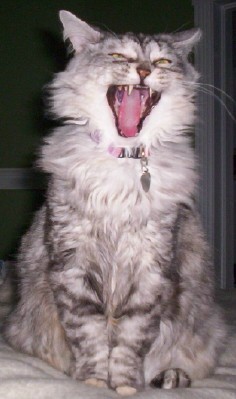
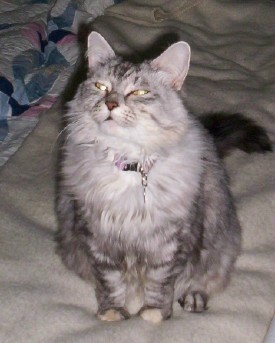
Two views of my sweet Lila. In the top picture, she's caught in mid-yawn. In the bottom one, she's making moon-eyes at me. Sweet thing.
We took Lila in yesterday for her appointment at the emergency vet's office to get the echocardiogram (the ultrasound) our regular doctor recommended. The good news is that Lila's heart is strong, healthy and showing no signs of the possibly progressive condition that Ezri has contracted. Lila's heart rate was high normal (which I attribute to stress...), and she had a slight gallop, but the ultrasound revealed no thickening of valves, no leaking/regurgitation of blood, nothing to be concerned about. I'm hugely relieved.
Now if we can just get Ezri in good shape. She's taking three pills a day (one every eight hours) for her heart condition. She gets another ultra sound in September. If the disease hasn't progressed, we'll know she had endocarditis, meaning an infection that scarred part of her heart. If the valves are still thickening, millimeter-by-millimeter, we'll have reason to be concerned that she really and truly has hypertrophic cardiomyopathy, a fatal heart disease.
 award-winning creator of the web series Abnormal Fixation (2024), the audio drama Enter the House Between (2023) and author of 35 books including Horror Films FAQ (2013), Horror Films of the 1990s (2011), Horror Films of the 1980s (2007), TV Year (2007), The Rock and Roll Film Encyclopedia (2007), Mercy in Her Eyes: The Films of Mira Nair (2006),, Best in Show: The Films of Christopher Guest and Company (2004), The Unseen Force: The Films of Sam Raimi (2004), An Askew View: The Films of Kevin Smith (2002), The Encyclopedia of Superheroes on Film & Television (2004), Exploring Space:1999 (1997), An Analytical Guide to TV's Battlestar Galactica (1998), Terror Television (2001), Space:1999 - The Forsaken (2003) and Horror Films of the 1970s (2002).
award-winning creator of the web series Abnormal Fixation (2024), the audio drama Enter the House Between (2023) and author of 35 books including Horror Films FAQ (2013), Horror Films of the 1990s (2011), Horror Films of the 1980s (2007), TV Year (2007), The Rock and Roll Film Encyclopedia (2007), Mercy in Her Eyes: The Films of Mira Nair (2006),, Best in Show: The Films of Christopher Guest and Company (2004), The Unseen Force: The Films of Sam Raimi (2004), An Askew View: The Films of Kevin Smith (2002), The Encyclopedia of Superheroes on Film & Television (2004), Exploring Space:1999 (1997), An Analytical Guide to TV's Battlestar Galactica (1998), Terror Television (2001), Space:1999 - The Forsaken (2003) and Horror Films of the 1970s (2002).
Farewell Carl Kolchak; Farewell Barney Fife
I'm going to start with Darren McGavin since this blog usually focuses on horror and sci-fi. This remarkable actor played so many great parts during his long and distinguished career (including private dick Mike Hammer; a series from the 1950s that was condemned for being overly violent...), yet it is for the one-of-a-kind role of Carl Kolchak - that dogged reporter and hunter of things supernatural - that this author will always remember him.
What an odd (and distinctive) bird Carl Kolchak was, in his bright white running shoes (which he wore to catch a good story...), his tatty old hat and seersucker suit. I loved how McGavin, as Kolchak, in the series credits for Kolchak: The Night Stalker (1974-75) would stroll into his run-down office at the INS, whistling a cheery tune...oblivious. Then, as he approached his desk, he'd toss his hat toward the far wall, as if there were a hook there to hang it on. There wasn't, and the hat just hit the floor. But Karl didn't seem to notice, or get bothered by that.
That was a wonderful, individual touch that spoke volumes about the character, and how he viewed his world. There was part of Kolchak who always wanted to return to the world of The New York Times or The Washington Post, - where reporters doubtlessly merited office hat racks - but the pesky truth kept getting in his way. The New York Times didn't want to hear about succubi or werewolves or zombies or vampires, that was for sure.
Mr. McGavin always brought a charming bluster, good humor and fly-in-the-ointment quality to Kolchak. Carl was forever the little man fighting city hall (in the post-Watergate era). My favorite scenes on the short-lived program inevitably involved Kolchak going toe-to-toe with an officious cop or political figure at a press conference. No matter whom he faced, Kolchak would never back down, never soft-pedal the truth...even if it could get him ejected from the event, thrown in jail, or on occasion, roughed up. My secret dream was always to see Carl Kolchak go one-on-one with Scott McClellan or Ari Fleischer in a Presidential Press Briefing. By God, then we'd either get some straight answers, and those guys would be forever "revealed" as dissemblers and apologists.
As we saw recently with the ill-fated remake, not just anybody can play Carl Kolchak. Mr. McGavin inhabited that unique, memorable character in a special way few actors manage today. In our modern culture, we're consumed with the idea of giving characters "back story," and "angst" and the like, but back in the days of the original Kolchak, McGavin created a memorable and individual personality without benefit of such trite writers' hooks. In the process, he made the man a legend.
I watched Kolchak: The Night Stalker again when it was released on DVD late last year, and it holds up well, thirty years later. My wife, Kathryn, had never watched the series before, and she fell madly in love with the show; much more than I expected. She couldn't wait to watch the next episode and judged - quite correctly, I think - that the series was always more about human nature (often, very funny human nature...), than about the monster of the week. So - yeah - the monster costumes may be dated, but McGavin's zeal in that role has prevented the show from aging a day. It's still relevant in today's world. It's easy to see why the actor had such a love affair with the part.
Here's a snippet from an obituary for Mr McGavin by Martin Weil at The Washington Post:
In the "Night Stalker" series, Mr. McGavin wore a porkpie hat to play reporter Carl Kolchak, who revealed the occult forces behind the reality of the Chicago streets. Mr. McGavin is widely remembered as the father in 1983's "A Christmas Story," a classic that reappears every year during the holiday season.
He was also Mike Hammer, the embodiment of the hard-nosed private eye, in the series based on the Mickey Spillane novels.
In dozens of roles in made-for-TV movies, in series, or in episodes of series, Mr. McGavin appeared cynical or curmudgeonly. But even if he was a grouch, he was frequently a grouch with a glint in his eye.
York McGavin said last night that the irascible on-screen figure was not the father he knew. He said, however, that his father was a professional who knew what was demanded of him, "took great pride in his craft" and came to work prepared.
And this, from The New York Times (in a piece by Nadine Brozan):
Spanning almost seven decades, his versatile career took him from "Macbeth" to "Marcus Welby M.D." He played General George S. Patton in the television biography "Ike" and appeared recently in "The "X Files," a show said to have been inspired by "The Night Stalker." He won an Emmy Award in 1990 for playing Candice Bergen's father in "Murphy Brown." He also was the voice for a time on Budweiser's "This Bud's for You" commercials.
I received an e-mail from my friend and fellow McGavin admirer, Howard Margolin - the host of Destinies: the Voice of Science Fiction, yesterday, making me aware of Mr. McGavin's passing. I was devastated by the loss, and then - suddenly - saddened all over again to learn that Don Knotts had passed away as well. It was a bad, bad weekend for cult TV lovers.
Mr. Knotts will always be remembered for The Andy Griffith Show, and the role of a lifetime, bumbler deputy Barney Fife. Even the name "Barney Fife" has come into the cultural lexicon as a short-hand reference to an inept cop. Knotts made that self-important but ultimately sweet character his own, and here in North Carolina, he (and Griffith too) are positively revered for their time in Mayberry. And with good reason.
Yet, growing up in New Jersey - far from Mayberry, my first acquaintance with Don Knotts' came through some childrens' movies he made for Walt Disney Studios in the 1970s, The Apple Dumpling Gang (1975) and The Apple Dumpling Gang Rides Again (1979).
I also always watched Mr. Knotts TV work on the jiggle-fest Three's Company. He played Mr. Furley, the building landlord, in the final years (1979-84) of that John Ritter sitcom, after the Ropers left the series. Even there, in that disco era relic (and even garbed in the most ridiculous 70s-style outfits imaginable), Knotts was incredibly funny. I'll never forget some of the comedic facial expressions he produced in that part. They were, to use an overrused term - classic.
In the genre, Don Knotts made a name for himself in some ridiculous comedies from the 1960s too, including The Incredible Mr. Limpet (1964), The Ghost and Mr. Chicken (1966) and The Reluctant Astronaut (1967). Those movies all boast a cult following, even today.
This is from The New York Times piece on Mr. Knotts, by Virginia Heffernan:
He was a generous performer who liked to share the stage, and he thrived in duets, teams, variety shows, ensembles. Back in New York, he noticed a man whose hands shook and who spilled water; he combined that with Robert Benchley's famous apologetic speaker from the monologue "Treasurer's Report," and the nervous character, who went on to fame on "The Steve Allen Show," was born. Mr. Knotts plainly stole stuff, and other comics didn't mind lending him material. He was wonderfully unthreatening to other male comics, all of whom could think of themselves as one step closer to leading men than Mr. Knotts was. It's hard to think of an actor, in fact, who got more helping hands than Mr. Knotts in his early days. Male actors were forever offering him parts, trying to get him to join their acts. Sharing the stage with this skinny, spazzy guy could only make them look more commanding.
Among these mentors was Andy Griffith, whom he met when they were both cast in the play "No Time for Sergeants" in 1955. Mr. Griffith and Mr. Knotts cracked each other up. A few years later, when Mr. Knotts proposed himself as a deputy to Andy Taylor on Mr. Griffith's sitcom, Mr. Griffith went for it. Andy's crinkly, deep-set eyes conveyed calm and sagacity, while Barney's popped ones expressed pure anxiety and something akin to horror at the demands of ordinary life.
Mr. Knotts's popular movies, "The Ghost and Mr. Chicken," "The Incredible Mr. Limpet," "The Reluctant Astronaut" and "The Shakiest Gun in the West," put him on a winning streak. To comedy geeks, especially the preteen kind, his send-up of 60's superheroism came as a delight and a relief.
Hollywood, the movie and TV world, and most of all, audiences, are truly going to miss Darren McGavin and Don Knotts. They were - purely and simply - the best. This blog wishes their respective families well during a difficult time of grief, and mourns with them.
 award-winning creator of the web series Abnormal Fixation (2024), the audio drama Enter the House Between (2023) and author of 35 books including Horror Films FAQ (2013), Horror Films of the 1990s (2011), Horror Films of the 1980s (2007), TV Year (2007), The Rock and Roll Film Encyclopedia (2007), Mercy in Her Eyes: The Films of Mira Nair (2006),, Best in Show: The Films of Christopher Guest and Company (2004), The Unseen Force: The Films of Sam Raimi (2004), An Askew View: The Films of Kevin Smith (2002), The Encyclopedia of Superheroes on Film & Television (2004), Exploring Space:1999 (1997), An Analytical Guide to TV's Battlestar Galactica (1998), Terror Television (2001), Space:1999 - The Forsaken (2003) and Horror Films of the 1970s (2002).
award-winning creator of the web series Abnormal Fixation (2024), the audio drama Enter the House Between (2023) and author of 35 books including Horror Films FAQ (2013), Horror Films of the 1990s (2011), Horror Films of the 1980s (2007), TV Year (2007), The Rock and Roll Film Encyclopedia (2007), Mercy in Her Eyes: The Films of Mira Nair (2006),, Best in Show: The Films of Christopher Guest and Company (2004), The Unseen Force: The Films of Sam Raimi (2004), An Askew View: The Films of Kevin Smith (2002), The Encyclopedia of Superheroes on Film & Television (2004), Exploring Space:1999 (1997), An Analytical Guide to TV's Battlestar Galactica (1998), Terror Television (2001), Space:1999 - The Forsaken (2003) and Horror Films of the 1970s (2002).
Saturday, February 25, 2006
SATURDAY MORNING CULT TV BLOGGING: Land of the Lost: "Cha-Ka"
 Our journey into Land of the Lost begins with the "Cha-Ka," the first episode of the three-season series (an an installment which aired in September of 1974). "Cha-Ka" was written by Tribbles creator David Gerrold and directed by Danny Steinmetz.
Our journey into Land of the Lost begins with the "Cha-Ka," the first episode of the three-season series (an an installment which aired in September of 1974). "Cha-Ka" was written by Tribbles creator David Gerrold and directed by Danny Steinmetz.The opening montage (and theme song) set up the premise of the series, for us, and this episode begins at least one day after the Marshalls (Rick, Holly and Will) have arrived in this seemingly-prehistoric world. The viewer first meets the Marshall family as it is peering over a swamp, and Holly has just named a small dinosaur "Spot." Will protests that a better name is required, but the debate is ended when a Tyrannosaurus, Grumpy, enters the scene with a roar. While Rick goes into the woods to gather supplies, Will and Holly happen upon a strange, construct in the forest, a pyramidal device "made by intelligent beings." This is a pylon. It's cold to the touch, Holly tells us, and Will says it feels like it's not even there.
The examination of the pylon is interrupted when Grumpy attacks three Pakuni - small ape-men creatures - nearby. The youngest of the Paku, Cha-Ka, falls and is injured in the escape, and Holly and Will rescue him. When Rick returns, they determine to bring Cha-Ka back to their cave at high bluff, and set his fractured ankle with a splint. Unfortunately, Grumpy is still around, and he's hungry...
"Cha-Ka" introduces the TV viewer to the world of Land of the Lost, including all the main characters. Holly, Will, Marshall, Cha-Ka and even Grumpy each get their moment in the sun. With the help of stop-motion photography and chroma-key composites (the overlaying of live-actors on highly-detailed miniature landscapes), this unique kid-vid series comes to life with a bang. One thing I noticed this time, watching the series, is Land of the Lost's unique sound-design. It literally sounds otherworldly, and between the music and dinosaur roars, you've never heard anything like this on any other television series. It's a distinctive, individual sound model, and that makes the show truly seem individual. Often, sound is ignored in favor of visuals, so I wanted to make note of this here. Turn on Land of the Lost anywhere in a house, and without looking at the TV, you'll know exactly what program is on the tube.
While blogging Land of the Lost, I'm going to try to keep track of the Marshalls' equipment, because they seem all kitted up for having been on a raft ride! I noticed in 'Cha-Ka" they have at least one canteen, a lighter, a grill (!), three sleeping bags, a pot, a plastic water jug, a yellow drinking mug, and at least seven back-packs (ostensibly half-emptied, since these supplies must have come from somewhere). At this point, they don't appear to have a change of clothes...
Because Land of the Lost was produced for little kids to enjoy on Saturday mornings, it's filled with valuable moral messages about the way people should treat others. After Holly makes fun of Grumpy the dinosaur, Rick admonishes her: "Don't call Grumpy names. It's not his fault he's stupid." Later, when Holly asks if she can keep Cha-Ka, this is the stern reply: "People don't own other people. Cha-Ka will stay with us just as long as he wants to."
Finally, the episode "Cha-Ka" introduces us to the Marshall's first (and only...) line of defense at High-Bluff, the "fly-swatter." This is a thick spear, carved to be more pointy (but not actually sharp...) at one end. When Grumpy tries to stick his toothy snout into the cave (and it's right at mouth level, unfortunately,..), the Marshalls get a running start and jam the fly swatter into his mouth. By the end of the episode, Grumpy has gotten smart to this trick. "He can learn things!," Holly notes. Yes, but he'll be back in future episodes...
You'll also note that there's a brief sojourn to the pylon in this episode, setting up future storylines. And Cha-Ka has now been well-established as an ally, since the Marshalls have set his injured leg. At episode's end, he returns the favor by bringing them fruit and vegetables from the forest.
Next week - "The Sleestak God!"
 award-winning creator of the web series Abnormal Fixation (2024), the audio drama Enter the House Between (2023) and author of 35 books including Horror Films FAQ (2013), Horror Films of the 1990s (2011), Horror Films of the 1980s (2007), TV Year (2007), The Rock and Roll Film Encyclopedia (2007), Mercy in Her Eyes: The Films of Mira Nair (2006),, Best in Show: The Films of Christopher Guest and Company (2004), The Unseen Force: The Films of Sam Raimi (2004), An Askew View: The Films of Kevin Smith (2002), The Encyclopedia of Superheroes on Film & Television (2004), Exploring Space:1999 (1997), An Analytical Guide to TV's Battlestar Galactica (1998), Terror Television (2001), Space:1999 - The Forsaken (2003) and Horror Films of the 1970s (2002).
award-winning creator of the web series Abnormal Fixation (2024), the audio drama Enter the House Between (2023) and author of 35 books including Horror Films FAQ (2013), Horror Films of the 1990s (2011), Horror Films of the 1980s (2007), TV Year (2007), The Rock and Roll Film Encyclopedia (2007), Mercy in Her Eyes: The Films of Mira Nair (2006),, Best in Show: The Films of Christopher Guest and Company (2004), The Unseen Force: The Films of Sam Raimi (2004), An Askew View: The Films of Kevin Smith (2002), The Encyclopedia of Superheroes on Film & Television (2004), Exploring Space:1999 (1997), An Analytical Guide to TV's Battlestar Galactica (1998), Terror Television (2001), Space:1999 - The Forsaken (2003) and Horror Films of the 1970s (2002).
SATURDAY MORNING CULT TV BLOGGING: Land of the Lost - A Primer:
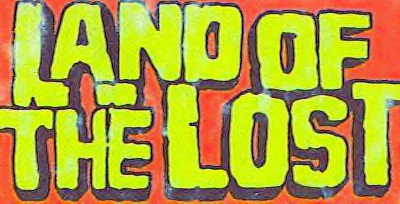
Guess which Saturday morning series I'm blogging next?
Truth be told, Land of the Lost is my all-time favorite Saturday morning series, even though I love space adventures like Space Academy and Jason of Star Command. I'm also a real fan of a forgotten series called Run, Joe, Run, about a dog/fugitive on the lam from the law, accused of a crime he didn't commit. It was also a live-action series, it starred a german shepherd, and it ran for two seasons, concurrent with Land of the Lost, if I'm not mistaken.
Anyway, I don't know if I'm committing yet to blog all three seasons of Land of the Lost, because that's forty-three episodes, and - well - I like to keep my options open. But I'll start with the first season, and then see how I'm feeling. The animated series Return to the Planet of the Apes is due out on DVD in a few short weeks, and I would also like to post about that for Saturday morning cult TV blogging too. I haven't seen that series since 1975!
I've written about Land of the Lost at length before. Here's a "retro-file" that I penned a few years ago, and it's replete with interviews from many of the people involved in the show, including Spencer Milligan (Rick Marshall), Walker Edmiston (Enik), co-creator Allan Foshko, Marty Krofft (producer), executive producer Albert Tenzer and more. Below is a snippet:
The year was 1974 B.C [Before Cable]...
Decades before Steven Spielberg and Michael Crichton ushered moviegoers through the gates of Jurassic Park, American children of the disco decade knew exactly where to get their fill of prehistoric action. For three seasons, from 1974 to 1976, every Saturday morning was reserved for NBC and the fantastic world of Sid and Marty Krofft's live action dinosaur romp, Land of the Lost.
A generation later, a big budget feature film is in the planning process and Rhino Entertainment has released a handful of original series episodes on DVD and VHS. Linda Laurie's series theme music has become part and parcel of the American pop culture landscape and it acquaints viewers with the story of Land of the Lost better than any synopsis.
To paraphrase, Marshall (Spencer Milligan), Will (Wesley Eure) and Holly (Kathy Coleman), on a routine expedition, experience the "greatest earthquake ever known." They plunge down a waterfall in the Grand Canyon and find themselves lost in a closed, prehistoric, pocket universe known to its bizarre denizens as - you guessed it - The Land of the Lost. In this brave new world, the Marshalls encounter friends such as Cha-Ka, a brave little Pakuni ape-boy, and a baby brontosaur, Dopey. However, even as they attempt to return to their twentieth century home using the Land of the Lost's strange crystal technology (housed in pyramidal stations termed pylons), the family grapples with a T-Rex named Grumpy, his distaff opponent, the allosaur Big Alice, and the nefarious Sleestak.
Hissing lizard people, the Sleestak are the devolved remnants of the once-advanced Altrusian culture and the inhabitants of a mysterious lost city hewn out of stone. On more than one occasion, the Sleestak seek to feed the Marshalls to their (off-screen) God, a bellowing monstrosity inhabiting a smoky pit.
Though all three Jurassic Park movies have deposited adults and kids in the path of rampaging dinosaurs, this was a revolutionary approach back in 1973 when the TV series was formulated; "We were trying to find a habitat that could feature dinosaurs and a family...and those two entities together worked out to be a really good combination," Marty Krofft remembers fondly.
He is also quick to credit his creative team for its input. "Great things happen when you have imaginative people aboard, and we had Allan Foshko, who had worked with us on other things, and it was a very collaborative effort. You have a few nightmares and you come up with these wild characters and places."
According to Foshko, series co-creator and then-vice-president in charge of new programming for the Kroffts, all of the dino-mite excitement commenced with Sid Krofft's long-standing affection for dinosaurs and dinosaur movies.
After that, however, it was up to Foshko to set the scene. "You can't go back in time as easily as you can create something new, so I thought about the possibility of how we could transport a team back into the prehistoric era," Foshko muses.
"After some research, I discovered the Grand Canyon had been underwater at some time in history, and it is the most awesome of our natural monuments. There are so many things about the Grand Canyon we don't know, and one of which was that there could have been another land underneath it, because a stream had eaten its way down through all those layers of sediment for millions of years. And so it seemed to me a perfect setting."
From that provocative notion, Foshko and the Kroffts shot a live-action, 30-minute pilot featuring a combination of then-revolutionary special effects, including matte paintings and blue screens. Featuring voice-over narration and clips of actors interacting with what Foshko calls "gargantuan beasts and dinosaurs," the pilot was test-marketed by NBC and the response was overwhelming."
"The pilot had the feel of Alice in Wonderland or Journey to the Center of the Earth, with these people falling into another world," Foshko remembers with enthusiasm. "The story just flowed, and with these hand-painted storyboards and collages, it was an unusual approach to doing this presentation. We had music and special effects and all kinds of magic. For TV, it was revolutionary..."
 award-winning creator of the web series Abnormal Fixation (2024), the audio drama Enter the House Between (2023) and author of 35 books including Horror Films FAQ (2013), Horror Films of the 1990s (2011), Horror Films of the 1980s (2007), TV Year (2007), The Rock and Roll Film Encyclopedia (2007), Mercy in Her Eyes: The Films of Mira Nair (2006),, Best in Show: The Films of Christopher Guest and Company (2004), The Unseen Force: The Films of Sam Raimi (2004), An Askew View: The Films of Kevin Smith (2002), The Encyclopedia of Superheroes on Film & Television (2004), Exploring Space:1999 (1997), An Analytical Guide to TV's Battlestar Galactica (1998), Terror Television (2001), Space:1999 - The Forsaken (2003) and Horror Films of the 1970s (2002).
award-winning creator of the web series Abnormal Fixation (2024), the audio drama Enter the House Between (2023) and author of 35 books including Horror Films FAQ (2013), Horror Films of the 1990s (2011), Horror Films of the 1980s (2007), TV Year (2007), The Rock and Roll Film Encyclopedia (2007), Mercy in Her Eyes: The Films of Mira Nair (2006),, Best in Show: The Films of Christopher Guest and Company (2004), The Unseen Force: The Films of Sam Raimi (2004), An Askew View: The Films of Kevin Smith (2002), The Encyclopedia of Superheroes on Film & Television (2004), Exploring Space:1999 (1997), An Analytical Guide to TV's Battlestar Galactica (1998), Terror Television (2001), Space:1999 - The Forsaken (2003) and Horror Films of the 1970s (2002).
Friday, February 24, 2006
Loving Bad Movies? What's Your Guilty Pleasure?
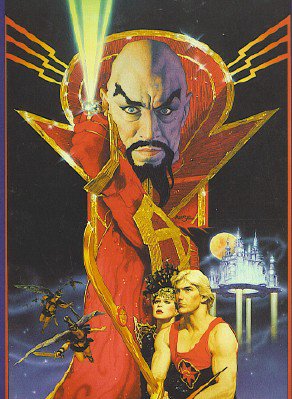
So here's the postulate: Can a movie's parts be enjoyable and interesting, even if the sum of those parts is less than quality? I wonder, why do we sometimes really get stuck on movies that are - in the final analysis - not very good? Why do we enjoy them, and perhaps more to the point, why do we go back to them again and again? This is something I'm always watching for and contemplating about, because I'm basically a professional critic. I ponder, what if that crazy gene is going to kick in and I'm going to shout to the world my objective, critical love of The Day After Tomorrow? Wouldn't that be embarrassing?
For me, one of those indefensible - but nonetheless compelling - films is surely 1980's big budget bomb Flash Gordon. My parents took me to see it in theaters in December 1980 for my 11th birthday, along with a gaggle of friends. I loved the film then, but I don't think that nostalgia accounts for the primary reason why.
On the surface, not only does Flash Gordon feature extraordinary production values and set design, but it's got that unbelievable score by Queen and a theme song for the ages. Flash! Savior of the Universe!
It doesn't hurt, either, I guess that the film features luscious Melody Anderson as Dale Ardor, er Arden, and the incomparable Ornella Muti as Princess Aura. Max Von Sydow makes an outrageous and memorable villain as Ming the Merciless and the movie boasts neat gadgets like rocket scooters. There's also a ludicrous (and amusing) "football" action set-piece in Ming's court. Why there's even gore! When Klytus falls on a platform of spikes, his eyes pop out. It's positively charming.
As a kid, I remember being terrified of that insect/monster-thing on Arborea too. You remember that don't you? Flash engages in a contest of wills with Prince Barin (Timothy Dalton!) and each man has to stick his bare arm into this gnarled tree trunk where that slimy creature lives. If the scorpion-y thing catches you, it snaps you with its stinger. This poisons you and you die a horrible death in minutes. No matter how bad the rest of the movie is, this scene still works on me. It's tense...
Watching the film today, I can plainly see the bad special effects (the wire-work involving the Hawkmen is particularly bad). It's not hard to detect Sam Jones' inexperience acting, either. And yet - AND YET - there's something magnificently opulent about this gold and silver fantasy world where planets look like giants tree stumps, moons are Mongo kingdoms and sexy women wear shoulder-pads and skin-tight bodysuits. I know Flash Gordon is meant to be camp, and I guess that's why many true believers hate this Dino De Laurentiis version, but I can pop the movie in the laserdisc player (yes, you read that right...) and watch it any time with a great deal of enjoyment.
So what's your indefensible movie pick? What's that one movie that you absolutely love with all your heart, but which your brain just tells you is bad, bad, bad? What's your guilty pleasure? Come on, ante up. I know you have one.
Some of my other choices in this category would likely include The Black Hole (1979), Godzilla 1985 and...gosh - I don't know if I should admit this, even in passing...
...The Postman (1997). Because he gives out hope like it's candy to a child...
Ride Postman! Ride!
 award-winning creator of the web series Abnormal Fixation (2024), the audio drama Enter the House Between (2023) and author of 35 books including Horror Films FAQ (2013), Horror Films of the 1990s (2011), Horror Films of the 1980s (2007), TV Year (2007), The Rock and Roll Film Encyclopedia (2007), Mercy in Her Eyes: The Films of Mira Nair (2006),, Best in Show: The Films of Christopher Guest and Company (2004), The Unseen Force: The Films of Sam Raimi (2004), An Askew View: The Films of Kevin Smith (2002), The Encyclopedia of Superheroes on Film & Television (2004), Exploring Space:1999 (1997), An Analytical Guide to TV's Battlestar Galactica (1998), Terror Television (2001), Space:1999 - The Forsaken (2003) and Horror Films of the 1970s (2002).
award-winning creator of the web series Abnormal Fixation (2024), the audio drama Enter the House Between (2023) and author of 35 books including Horror Films FAQ (2013), Horror Films of the 1990s (2011), Horror Films of the 1980s (2007), TV Year (2007), The Rock and Roll Film Encyclopedia (2007), Mercy in Her Eyes: The Films of Mira Nair (2006),, Best in Show: The Films of Christopher Guest and Company (2004), The Unseen Force: The Films of Sam Raimi (2004), An Askew View: The Films of Kevin Smith (2002), The Encyclopedia of Superheroes on Film & Television (2004), Exploring Space:1999 (1997), An Analytical Guide to TV's Battlestar Galactica (1998), Terror Television (2001), Space:1999 - The Forsaken (2003) and Horror Films of the 1970s (2002).
Thursday, February 23, 2006
Behind the Screen: This is Spinal Tap ...Now Available for Pre-Order!
On its theatrical release in 1984, Rob Reiner’s hilarious satire about the self-indulgent excesses of a washed-up heavy metal band met with rave reviews but only lukewarm reaction from audiences, many of whom didn’t quite grasp that the film was, in fact, a spoof. Now, nearly a quarter century after its original release, This is Spinal Tap is recognized as a classic, the standard by which other mockumentaries are judged, and continues to entertain fans and attract critical acclaim.
Here, John Kenneth Muir, an ex
Street date on the book is August 28, 2006, and the price is 9.95! Which makes it more affordable than some of my older tomes! Check it out! I'll be blogging more about the book as we get closer to August. And don't forget, I've got Mercy in Her Eyes: The Films of Mira Nair
 award-winning creator of the web series Abnormal Fixation (2024), the audio drama Enter the House Between (2023) and author of 35 books including Horror Films FAQ (2013), Horror Films of the 1990s (2011), Horror Films of the 1980s (2007), TV Year (2007), The Rock and Roll Film Encyclopedia (2007), Mercy in Her Eyes: The Films of Mira Nair (2006),, Best in Show: The Films of Christopher Guest and Company (2004), The Unseen Force: The Films of Sam Raimi (2004), An Askew View: The Films of Kevin Smith (2002), The Encyclopedia of Superheroes on Film & Television (2004), Exploring Space:1999 (1997), An Analytical Guide to TV's Battlestar Galactica (1998), Terror Television (2001), Space:1999 - The Forsaken (2003) and Horror Films of the 1970s (2002).
award-winning creator of the web series Abnormal Fixation (2024), the audio drama Enter the House Between (2023) and author of 35 books including Horror Films FAQ (2013), Horror Films of the 1990s (2011), Horror Films of the 1980s (2007), TV Year (2007), The Rock and Roll Film Encyclopedia (2007), Mercy in Her Eyes: The Films of Mira Nair (2006),, Best in Show: The Films of Christopher Guest and Company (2004), The Unseen Force: The Films of Sam Raimi (2004), An Askew View: The Films of Kevin Smith (2002), The Encyclopedia of Superheroes on Film & Television (2004), Exploring Space:1999 (1997), An Analytical Guide to TV's Battlestar Galactica (1998), Terror Television (2001), Space:1999 - The Forsaken (2003) and Horror Films of the 1970s (2002).
Look Who Beamed Down!
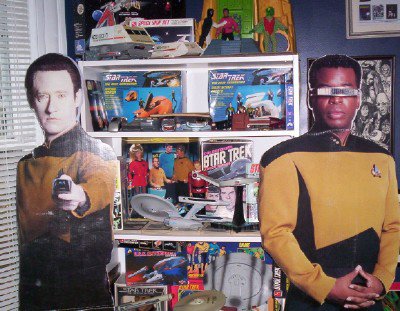
 award-winning creator of the web series Abnormal Fixation (2024), the audio drama Enter the House Between (2023) and author of 35 books including Horror Films FAQ (2013), Horror Films of the 1990s (2011), Horror Films of the 1980s (2007), TV Year (2007), The Rock and Roll Film Encyclopedia (2007), Mercy in Her Eyes: The Films of Mira Nair (2006),, Best in Show: The Films of Christopher Guest and Company (2004), The Unseen Force: The Films of Sam Raimi (2004), An Askew View: The Films of Kevin Smith (2002), The Encyclopedia of Superheroes on Film & Television (2004), Exploring Space:1999 (1997), An Analytical Guide to TV's Battlestar Galactica (1998), Terror Television (2001), Space:1999 - The Forsaken (2003) and Horror Films of the 1970s (2002).
award-winning creator of the web series Abnormal Fixation (2024), the audio drama Enter the House Between (2023) and author of 35 books including Horror Films FAQ (2013), Horror Films of the 1990s (2011), Horror Films of the 1980s (2007), TV Year (2007), The Rock and Roll Film Encyclopedia (2007), Mercy in Her Eyes: The Films of Mira Nair (2006),, Best in Show: The Films of Christopher Guest and Company (2004), The Unseen Force: The Films of Sam Raimi (2004), An Askew View: The Films of Kevin Smith (2002), The Encyclopedia of Superheroes on Film & Television (2004), Exploring Space:1999 (1997), An Analytical Guide to TV's Battlestar Galactica (1998), Terror Television (2001), Space:1999 - The Forsaken (2003) and Horror Films of the 1970s (2002).
RETRO TOY FLASHBACK # 31: Star Trek: The Motion Picture Toys

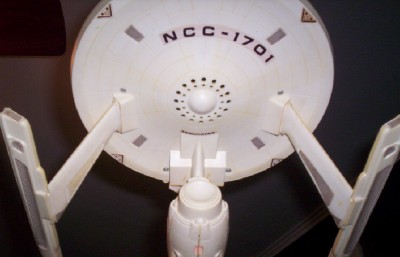
 December 7th, 1979 is a day that I will never forget. This was the day that Star Trek: The Motion Picture was released to theaters nationwide. I was in fourth grade and I guess I had just turned ten on the 3rd of December. On that opening weekend - Saturday - my parents took my sister and me to see the Star Trek movie at Essex Green Cinemas, and I fell in love with it. I brought along my Mego Captain Kirk figure (from the TV series...) I remember flying him around Marshalls...
December 7th, 1979 is a day that I will never forget. This was the day that Star Trek: The Motion Picture was released to theaters nationwide. I was in fourth grade and I guess I had just turned ten on the 3rd of December. On that opening weekend - Saturday - my parents took my sister and me to see the Star Trek movie at Essex Green Cinemas, and I fell in love with it. I brought along my Mego Captain Kirk figure (from the TV series...) I remember flying him around Marshalls...When the lights went down in the theater, the
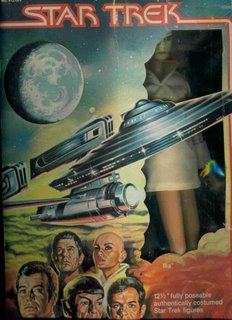 movie opened with a sequence that - back in the day - was a special effects show stopper. Three Klingon warships attacked the V'Ger cloud in deep space and were promptly obliterated. Even as a kid, I noted the incredible, bravura shot in which the camera seemed to swoop around the turtle-head command port of the Klingon ship. And the Klingons - now Bumpy headed instead of vaguely Asianl - were neat.
movie opened with a sequence that - back in the day - was a special effects show stopper. Three Klingon warships attacked the V'Ger cloud in deep space and were promptly obliterated. Even as a kid, I noted the incredible, bravura shot in which the camera seemed to swoop around the turtle-head command port of the Klingon ship. And the Klingons - now Bumpy headed instead of vaguely Asianl - were neat.This was the beginning period of "my" Star Trek. I say that because the original series (which I live and breathe and adore) was made before I was born, and the Next Generation and all its spin offs came after I was a teenager. But the movies came right at the time when my young, pliable brain could use them the most; as a kid developing a love of science fiction. I remember reading all the negative reviews of the film. But I loved it anyway. Still do. And, if you get me in an argumentative mood, I will make my case why I still feel it's the
 most cinematic of all Star Trek films.
most cinematic of all Star Trek films.Anyway, there was a merchandising blitz back in 1979 to celebrate the release of Star Trek: The Motion Picture. As you can guess from reading all of these retro flashbacks, I was lucky to have indulgent parents, and they were more than generous about buying me toys.
The items I was most interested to play with were the fascinating spaceships featured in the film. The new Enterprise was jaw-droppingly beautiful, and AMT released a fantastic, highly-detailed kit (replete with rainbow "warp drive" stickers for the nacelles). The only problem was that it cost $20.00
To me, that was a lot of money, but my
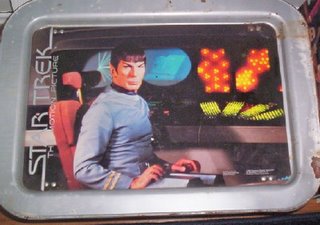 parents bought it without commenting on the exorbitant price, and my Dad built it beautifully. The ship was gorgeous. Even more generously, I was allowed to pick a second Star Trek model to go with it: either the Klingon battlecruiser or the Vulcan shuttle. At the time, I picked the Vulcan shuttle, because I was fascinated by the way the cruiser separated into two parts (passenger section and warp sled). I had to wait only for Christmas a few weeks later before I also had the Klingon cruiser. These kits were later re-issued, save, I think, for the Vulcan shuttle.
parents bought it without commenting on the exorbitant price, and my Dad built it beautifully. The ship was gorgeous. Even more generously, I was allowed to pick a second Star Trek model to go with it: either the Klingon battlecruiser or the Vulcan shuttle. At the time, I picked the Vulcan shuttle, because I was fascinated by the way the cruiser separated into two parts (passenger section and warp sled). I had to wait only for Christmas a few weeks later before I also had the Klingon cruiser. These kits were later re-issued, save, I think, for the Vulcan shuttle.Mego, of course, owned the license to
 produce Star Trek figures. I collected these little guys eagerly (Kirk, Spock, Bones, Scotty, Decker and Ilia), but was disappointed that none came with phasers, wrist communicators or tricorders. How lame was that!? Mego also released a line of larger figures that were - also - sans equipment. I never did get my hands on the rarer-than-rare Klingons and other aliens.
produce Star Trek figures. I collected these little guys eagerly (Kirk, Spock, Bones, Scotty, Decker and Ilia), but was disappointed that none came with phasers, wrist communicators or tricorders. How lame was that!? Mego also released a line of larger figures that were - also - sans equipment. I never did get my hands on the rarer-than-rare Klingons and other aliens.Talk about a weird collectible, Knickerbocker Toys released two Star Trek "plush figures." This means they were essentially like little teddy bears, but these "soft poseable figures" were molded to resemble Kirk (in his two-tone Admiral's uniform) and Spock. I guess a lot of folks over the years have wanted to cuddle into bed with Kirk and Spock, but I wasn't necessarily one of 'em. They do look nice displayed on a shelf, however.
The blitz continued with a wide array of other
 Star Trek items. There was a silver metal Star Trek portable dinner tray! I found this at a flea market in North Carolina sometime in the mid-1990s. It's rusted in spots, but it was too good to pass up.
Star Trek items. There was a silver metal Star Trek portable dinner tray! I found this at a flea market in North Carolina sometime in the mid-1990s. It's rusted in spots, but it was too good to pass up.Also, Marvel released in at least three editions (a three-part comic series, a super-special and a hardbound book...) its adaptation of The Motion Picture. The adaptation featured the deleted V'Ger crystal attack during a spacewalk by Kirk and Spock. Other collectibles I've featured here before: calendars, phasers, record albums and the like.
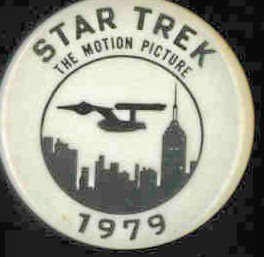 One of my favorite collectibles is a probably-unofficial button promoting the release of Star Trek: the Motion Picture in New York City. The button features the Enterprise (the TV version...) over Manhattan and provides a date, as you can see.
One of my favorite collectibles is a probably-unofficial button promoting the release of Star Trek: the Motion Picture in New York City. The button features the Enterprise (the TV version...) over Manhattan and provides a date, as you can see.I also have a Star Trek belt-buckle, and then this Coleco Electronic U.S.S. Enterprise. This toy whoops and holler - like most toy spaceships - with sounds of phasers, engines and the like, but the cool thing about this toy (pictured at top of post) is that you can unhook the nacelles and re-hook them all over the ship
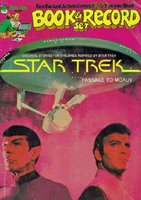 (hull and saucer section) to make different class Starfleet vessels. Since I imagined myself the captain of my own ship, with my own crew, it was fun to have an "alternate" ship too.
(hull and saucer section) to make different class Starfleet vessels. Since I imagined myself the captain of my own ship, with my own crew, it was fun to have an "alternate" ship too.The later original cast Star Trek movies never seemed to generate as much merchandise as The Motion Picture, and that always disappointed me. But Motion Picture merchandise is also one of a kind because the crew appears so different here than in their other big screen excursions. The crew only wore these wrist communicators once. They only adorned these costumes (which I liked!) once. They were only this skinny once...
 award-winning creator of the web series Abnormal Fixation (2024), the audio drama Enter the House Between (2023) and author of 35 books including Horror Films FAQ (2013), Horror Films of the 1990s (2011), Horror Films of the 1980s (2007), TV Year (2007), The Rock and Roll Film Encyclopedia (2007), Mercy in Her Eyes: The Films of Mira Nair (2006),, Best in Show: The Films of Christopher Guest and Company (2004), The Unseen Force: The Films of Sam Raimi (2004), An Askew View: The Films of Kevin Smith (2002), The Encyclopedia of Superheroes on Film & Television (2004), Exploring Space:1999 (1997), An Analytical Guide to TV's Battlestar Galactica (1998), Terror Television (2001), Space:1999 - The Forsaken (2003) and Horror Films of the 1970s (2002).
award-winning creator of the web series Abnormal Fixation (2024), the audio drama Enter the House Between (2023) and author of 35 books including Horror Films FAQ (2013), Horror Films of the 1990s (2011), Horror Films of the 1980s (2007), TV Year (2007), The Rock and Roll Film Encyclopedia (2007), Mercy in Her Eyes: The Films of Mira Nair (2006),, Best in Show: The Films of Christopher Guest and Company (2004), The Unseen Force: The Films of Sam Raimi (2004), An Askew View: The Films of Kevin Smith (2002), The Encyclopedia of Superheroes on Film & Television (2004), Exploring Space:1999 (1997), An Analytical Guide to TV's Battlestar Galactica (1998), Terror Television (2001), Space:1999 - The Forsaken (2003) and Horror Films of the 1970s (2002).
Wednesday, February 22, 2006
The Laws of Bad Sequels

Yesterday, I blogged about some terrible movie sub-titles. Warlock's The Armageddon and Star Trek's Nemesis were on that list, for instance.
But for some reason I've been stuck on this thought of weak follow-up franchise films, and today wanted to meditate on which sequels are really bad, and why. There are any number of reasons why a sequel might fail, I guess, so I'm going to enumerate some of the common "laws" of bad sequels and name a few egregious examples.
The Poltergeist III Law of Cast Changes. I understand why, on occasion, sequels have to be produced without returning cast-members. Perhaps actors are not available, unwilling to return, or - God Forbid - have passed away between installments. Often, a movie can indeed get around a cast change with a little ingenuity and intelligence (The Matrix Revolutions; "The Oracle"). But other times...yikes! For instance, the entire Poltergeist film franchise concerns a family, the Freelings, coping with a supernatural attack. That supernatural assault, depicted in Poltergeist (1982) and The Other Side (1986) brings the family closer together. The Freelings lose their house, but they gain togetherness. I mean, Mom Freeling (JoBeth Williams) actually crosses into the nether realm to bring back her daughter, Carol Anne. The family is tight-knit...clearly. And though a cast member, sadly, was killed (Dominique Dunne) before it was produced, the first sequel, The Other Side at least had a reason for her absence: the character was away at college. Okay, that's believable as far is it goes.
However, for Poltergeist III, we are supposed to believe that Mommy & Daddy Freeling have sent their little ten-year-old girl to Chicago to stay with an aunt and uncle and attend school. Now, this is the girl who is the fulcrum of the continuing poltergeist manifestations. The one who has been abducted to the other side, and twice pursued. Worse, the movie establishes that psychic Tangina has time to board a plane and get to Chicago to protect Carol Ann because she senses danger. What, she couldn't spring for a telephone call to Steve and Diane Freeling on the way? You don't think they would have shown up in a heartbeat to help their daughter out? And they didn't even warn their relatives that, ahem, Carol Anne has an unusual history?
Of course, the actors (Craig T. Nelson and Williams) didn't want to return for Poltergeist III, but - for me, anyway - it's just never really believable that this very close family, having survived all these terrors, would just send their daughter off to a different state. Especially knowing that "the Other Side" has taken her before and will most likely try again. I prefer the Predator 2 approach to cast changes. Arnold wasn't going to be involved, so a new character, played by Danny Glover was created. The Predator, his tools, his nature, remained the same, however.
The Star Trek V: The Final Frontier Law (Or Let's Make it Cheap & Funny) : Mea culpa, here. There are parts of Star Trek V: The Final Frontier I absolutely adore. I can watch it anytime and get a kick out of it. Anytime I see the original cast in action...I melt. But, come on...this entry is not exactly a "quality" Star Trek film. And I think that's for two reasons.
One, the producers cheaped out on special effects so that the visuals became laughable.
And two, and more importantly (and this isn't Shatner's fault...), the studio demanded that the script be "funny" like the successful previous entry, The Voyage Home. Shatner and his cohorts wrote a serious treatment about religious zealotry, with epic battles, divided loyalties and the like. And that all got cut out. Between the new accent on silly humor (Scotty bonking his head in Engineering) and the low-tech effects, the result is a deeply messed-up sequel that comes off as campy. So, note to future sequel makers: don't cut the corners so much that special effects stink, and don't force moviemakers to compromise their vision for the sake of adding humor.
The Jaws: The Revenge Rule (Or Keep it Simple). "This time, it's personal." Why? This sequel is so god-awful, and it actually combines a number of "bad sequel" laws. Again, the good, name cast of Jaws has been replaced. No Richard Dreyfuss. No Roy Scheider. Even the kids who survived Jaws II don't make a return. Who's our lead? Lorraine Gary, playing Mrs. Brody. That's excitement for you. More action movies need to star my Granny.
But the real reason Jaws: The Revenge is so unrelentingly bad is the concept erosion, and the effort to pile on ridiculous details to what should be a simple thriller. Horror movies work best when they have a pretty cut & dry premise that exploits a universal fear. A great white shark is one scary mother%(#*$. So why - in God's name - do you take this already fearsome force of nature on a ridiculous "quest" to kill off the Brodys. Like this is a clan battle between the McCoys and Hatfields or something. Why do you grant the shark the supernatural ability to swim across the world in less than a day? Why is the shark seemingly able to target Brodys amongst scores of other swimmers in the water (and yet still miss the little Brody girl on a banana boat, and strike the kid next to her?) Missed her by...that much! This is a classic example of overthinking a sequel, and destroying the original film's brilliant, elegant and simple concept. Jaws should be a really simple movie series to do. Men + shark = terror. Just add water.
The House & House 2: The Second Story Rule (Or, if you liked the first, you won't recognize the second!) Or, what I call, the rule of "in name only." When a film ends with the death of a hero, or even the death of a villain, sometimes it is hard to make a sequel that is consistent with the original installment. So what is a producer to do? Why, you make a totally new movie with different characters, different concerns, a different director, and slap a franchise name on it. You see, each one is about a different haunted house? Right! (And weirdly, both House movies star cast members from the TV series Cheers.) But the people who enjoyed the horror spectacle of William Katt fighting an evil Vietnam Vet ghost and rescuing his son from the nether realm aren't necessarily going to enjoy a comedy sequel, starring Arye Gross and a stupid-looking baby pterodactyl. Get it?
The H20 Rule (Or, Just Kidding! The Last Three Movies Took Place in an Alternate Universe Law): I liked H20 well enough, and I enjoyed seeing Jamie Lee Curtis back in action against Michael Myers. But okay, you know what? I also loved Ellie Cornell and Danielle Harris in Halloween IV: The Return of Michael Myers (1988). Halloween H20 negates that film's very existence. It takes the saga back to Halloween II. Of course, considering that you can get rid of Halloween V and VI too, maybe it's not such a bad deal. Still, this idea seems like really bad business. With the DVD market making all these movies available, you may keep your wallet in your pocket and safely skip movies IV - VI, and just watch parts I, II, and H20. That should be good for sales...
Finally, PART 3 in 3-D Law: Friday the 13th Part III in 3-D, Amityville 3-D and Jaws 3-D. Nuff said. Franchises which were previously scary (or at least creepy) are suddenly reduced to pointing sharp objects at the camera.
What are your laws of bad sequels? And what is the worst sequel of all time?
 award-winning creator of the web series Abnormal Fixation (2024), the audio drama Enter the House Between (2023) and author of 35 books including Horror Films FAQ (2013), Horror Films of the 1990s (2011), Horror Films of the 1980s (2007), TV Year (2007), The Rock and Roll Film Encyclopedia (2007), Mercy in Her Eyes: The Films of Mira Nair (2006),, Best in Show: The Films of Christopher Guest and Company (2004), The Unseen Force: The Films of Sam Raimi (2004), An Askew View: The Films of Kevin Smith (2002), The Encyclopedia of Superheroes on Film & Television (2004), Exploring Space:1999 (1997), An Analytical Guide to TV's Battlestar Galactica (1998), Terror Television (2001), Space:1999 - The Forsaken (2003) and Horror Films of the 1970s (2002).
award-winning creator of the web series Abnormal Fixation (2024), the audio drama Enter the House Between (2023) and author of 35 books including Horror Films FAQ (2013), Horror Films of the 1990s (2011), Horror Films of the 1980s (2007), TV Year (2007), The Rock and Roll Film Encyclopedia (2007), Mercy in Her Eyes: The Films of Mira Nair (2006),, Best in Show: The Films of Christopher Guest and Company (2004), The Unseen Force: The Films of Sam Raimi (2004), An Askew View: The Films of Kevin Smith (2002), The Encyclopedia of Superheroes on Film & Television (2004), Exploring Space:1999 (1997), An Analytical Guide to TV's Battlestar Galactica (1998), Terror Television (2001), Space:1999 - The Forsaken (2003) and Horror Films of the 1970s (2002).
Tuesday, February 21, 2006
Sci-Fi Wisdom of the Week: Poltergeist
Some people believe that when people die, there's a wonderful light as bright as the sun, but it doesn't hurt to look into it. All the answers to all the questions you ever want to know are inside that light. And when you walk to it, you become a part of it forever....
And then some people die, but don't know that they've gone. Maybe they didn't want to die. Maybe they weren't ready. Maybe they hadn't lived fully, or they'd live a long, long time and they still wanted more life. They resist going into that light, however hard the light wants them.
They just hang around. Watch TV. Watch their friends grow up, feeling unhappy and jealous. Those feelings are bad. They hurt.
And some people just get lost on the way to the light and they need someone to guide them to it..."
-Dr. Lesh (Beatrice Straight), explains the afterlife to Robbie Freeling (Oliver Robbins) in Poltergeist (1982)
 award-winning creator of the web series Abnormal Fixation (2024), the audio drama Enter the House Between (2023) and author of 35 books including Horror Films FAQ (2013), Horror Films of the 1990s (2011), Horror Films of the 1980s (2007), TV Year (2007), The Rock and Roll Film Encyclopedia (2007), Mercy in Her Eyes: The Films of Mira Nair (2006),, Best in Show: The Films of Christopher Guest and Company (2004), The Unseen Force: The Films of Sam Raimi (2004), An Askew View: The Films of Kevin Smith (2002), The Encyclopedia of Superheroes on Film & Television (2004), Exploring Space:1999 (1997), An Analytical Guide to TV's Battlestar Galactica (1998), Terror Television (2001), Space:1999 - The Forsaken (2003) and Horror Films of the 1970s (2002).
award-winning creator of the web series Abnormal Fixation (2024), the audio drama Enter the House Between (2023) and author of 35 books including Horror Films FAQ (2013), Horror Films of the 1990s (2011), Horror Films of the 1980s (2007), TV Year (2007), The Rock and Roll Film Encyclopedia (2007), Mercy in Her Eyes: The Films of Mira Nair (2006),, Best in Show: The Films of Christopher Guest and Company (2004), The Unseen Force: The Films of Sam Raimi (2004), An Askew View: The Films of Kevin Smith (2002), The Encyclopedia of Superheroes on Film & Television (2004), Exploring Space:1999 (1997), An Analytical Guide to TV's Battlestar Galactica (1998), Terror Television (2001), Space:1999 - The Forsaken (2003) and Horror Films of the 1970s (2002).
CATNAP 32: Caught in the Act!


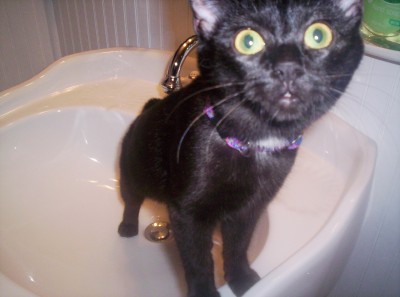
You may have seen the bottom picture on the blog before, but since they all involved her sink trick, I figured I'd post it anyway...
 award-winning creator of the web series Abnormal Fixation (2024), the audio drama Enter the House Between (2023) and author of 35 books including Horror Films FAQ (2013), Horror Films of the 1990s (2011), Horror Films of the 1980s (2007), TV Year (2007), The Rock and Roll Film Encyclopedia (2007), Mercy in Her Eyes: The Films of Mira Nair (2006),, Best in Show: The Films of Christopher Guest and Company (2004), The Unseen Force: The Films of Sam Raimi (2004), An Askew View: The Films of Kevin Smith (2002), The Encyclopedia of Superheroes on Film & Television (2004), Exploring Space:1999 (1997), An Analytical Guide to TV's Battlestar Galactica (1998), Terror Television (2001), Space:1999 - The Forsaken (2003) and Horror Films of the 1970s (2002).
award-winning creator of the web series Abnormal Fixation (2024), the audio drama Enter the House Between (2023) and author of 35 books including Horror Films FAQ (2013), Horror Films of the 1990s (2011), Horror Films of the 1980s (2007), TV Year (2007), The Rock and Roll Film Encyclopedia (2007), Mercy in Her Eyes: The Films of Mira Nair (2006),, Best in Show: The Films of Christopher Guest and Company (2004), The Unseen Force: The Films of Sam Raimi (2004), An Askew View: The Films of Kevin Smith (2002), The Encyclopedia of Superheroes on Film & Television (2004), Exploring Space:1999 (1997), An Analytical Guide to TV's Battlestar Galactica (1998), Terror Television (2001), Space:1999 - The Forsaken (2003) and Horror Films of the 1970s (2002).
Monday, February 20, 2006
Once More Unto The Breach: Our Fantasy Nemesis?
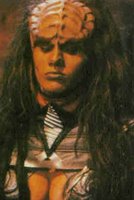 On the blog in the last weeks, we've selected our ship-of-the-line (Enterprise, NCC -1701 A), our sidekick droids, our irritating, troublemaking kids, - our space babes too - and even our dedicated CMO. Now comes an especially difficult choice. We're on a routine mission (perhaps cataloguing gaseous anomalies or some such thing). You're in command, and suddenly receive orders from our HQ. The ship has been ordered into battle at once.
On the blog in the last weeks, we've selected our ship-of-the-line (Enterprise, NCC -1701 A), our sidekick droids, our irritating, troublemaking kids, - our space babes too - and even our dedicated CMO. Now comes an especially difficult choice. We're on a routine mission (perhaps cataloguing gaseous anomalies or some such thing). You're in command, and suddenly receive orders from our HQ. The ship has been ordered into battle at once.So, your communications officer gives you the message, providing the coordinates. Who do you think - we're fighting? Who's the ultimate bad guy?
Gene Roddenberry's Star Trek is really the Great Bird of the Galaxy when it comes to memorable villains. An obvious choice would
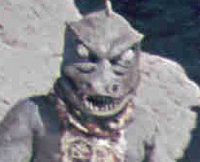 be the Romulan Star Empire (shall we race across the neutral zone)? Or perhaps even those ridge-headed Klingons. Watch out for de-cloaking birds of prey! If we're captured, we'll have to face the "mind-sifter."
be the Romulan Star Empire (shall we race across the neutral zone)? Or perhaps even those ridge-headed Klingons. Watch out for de-cloaking birds of prey! If we're captured, we'll have to face the "mind-sifter."But we musn't forget that over the years Star Trek has also provided audiences with so many other great antagonistic races. One of my favorites, and one of the most underutilized is the Gorn Empire. Remember the Gorn? From Cestus III and that first season episode "Arena?"
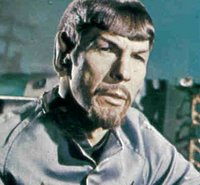 The Metrons kept the Federation and Gorn Empire from fighting, but didn't you always have the desire to see the Gorn return for head-to-head combat with Captain Kirk? I know I did. I bet they had really cool battleships.
The Metrons kept the Federation and Gorn Empire from fighting, but didn't you always have the desire to see the Gorn return for head-to-head combat with Captain Kirk? I know I did. I bet they had really cool battleships.While we're at it, what if the orders we just received involve a breach of universes. What if we're suddenly facing a "mirror" Empire versions of ourselves? The Star Trek episode "Mirror, Mirror" in the second season proved that a Captain Spock with goatee could be a powerful adversary. Would we take on the I.S.S. Enterprise? Could we
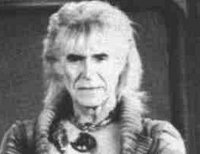 convince him of the illogic of fighting for an Empire he knows can't last?
convince him of the illogic of fighting for an Empire he knows can't last?If we're talking about a charismatic, individual villain, rather than a race of 'em, our choice might be Khan Noonian Singh (Ricardo Montalban). He's out for vengeance, and if he has a Genesis device in his arsenal, we're really in trouble. "Universal Armageddon," here we comes. The bad news is that once we start fighting Khan, he'll chase us round the moons of Nibia, the Antares Maelstrom and round Perdition's flames
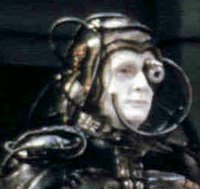 before he gives us up. And I, for one, don't want a Ceti Eel poking around my brain if we get captured and defeated. The key to defeating Khan? He's a two-dimensional thinker...
before he gives us up. And I, for one, don't want a Ceti Eel poking around my brain if we get captured and defeated. The key to defeating Khan? He's a two-dimensional thinker...If we're looking at the Next Generation, the end-all-be-all nemesis is no doubt The Borg Collective. I'll never forget the first episode featuring the Borg "Q-Who." I taped the episode because I was out on a date with a girl I really liked (this was on a trip home from U of R), and I finally watched the episode at about midnight. It was so good, I had to watch it a second time. I'll always remember how scary the Borg were in that
 original incarnation, back then, before they became mainstreamed, before "Hugh." At that point, the Borg were not seeking a Locutus-style spokesman. Instead, they were "the ultimate users," merely looking for technology to consume. That description still gives me chills. To the Borg, we're nothing but spare parts and biological fodder.
original incarnation, back then, before they became mainstreamed, before "Hugh." At that point, the Borg were not seeking a Locutus-style spokesman. Instead, they were "the ultimate users," merely looking for technology to consume. That description still gives me chills. To the Borg, we're nothing but spare parts and biological fodder.Outside of Star Trek, the genre has provided a number of fascinating villains over the years. Perhaps the Number One science fiction villain of all time - TV or film - is Darth Vader, a Dark Lord of the
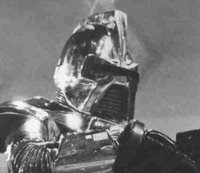 Sith. The ultimate Star Wars villain, (and tragic hero?) he commands that super-star destroyer, not to mention the Dark Side of the Force. He also flies one mean TIE fighter. And please, if you choose him, don't remind him that he killed Padme...
Sith. The ultimate Star Wars villain, (and tragic hero?) he commands that super-star destroyer, not to mention the Dark Side of the Force. He also flies one mean TIE fighter. And please, if you choose him, don't remind him that he killed Padme...Robotic menaces always seem popular on TV too. We could face off against the Cylon Empire from the original Battlestar Galactica. They boast lousy aim, but are known for Kamikaze strikes against Battlestars. A real technological menace, these "Red Eyes" have
 impressive ships, including the Cylon Raiders and those massive Basestars. And let's just hope they don't get us in range of that pulsar cannon on Ice Planet Zero.
impressive ships, including the Cylon Raiders and those massive Basestars. And let's just hope they don't get us in range of that pulsar cannon on Ice Planet Zero.Another metallic menace of a sort comes from the universe of Doctor Who. The cry of EXTERMINATE!!! comes from the race of conquerors known as The Daleks. True, they have difficulty with staircases (or they used too...) and their arms look like toilet bowl plungers. But they're still pretty scary. Personally, I always sort of liked the Cybermen better.
 Sci-Fi TV has also created a number of gorgeous, though thoroughly evil, women antagonists. Back in 1978, on Buck Rogers in the 25th Century, producer Glen Larson introduced us to Princess Ardala of the Draconian Realm, played by luscious Pamela Hensley. I've provided a near-full body shot of her for this post, because, well...how could I not? Ardala is absolutely gorgeous, she looks great in horns (!) and she commands the flagship of the Draconian Empire, the Draconia. It's a warship teeming with Draconian Marauders, or "hatchet" fighters. She wants to control the Earth at all costs. And she's kinda nasty. Her second-in-command is Kane, and she delegates a lot of the day-to-day operations to him. But she dreams of unseating her father, the Emperor Draco, and will do anything to achieve that aim...including marrying the genetically perfect man (who is, of course, me...)
Sci-Fi TV has also created a number of gorgeous, though thoroughly evil, women antagonists. Back in 1978, on Buck Rogers in the 25th Century, producer Glen Larson introduced us to Princess Ardala of the Draconian Realm, played by luscious Pamela Hensley. I've provided a near-full body shot of her for this post, because, well...how could I not? Ardala is absolutely gorgeous, she looks great in horns (!) and she commands the flagship of the Draconian Empire, the Draconia. It's a warship teeming with Draconian Marauders, or "hatchet" fighters. She wants to control the Earth at all costs. And she's kinda nasty. Her second-in-command is Kane, and she delegates a lot of the day-to-day operations to him. But she dreams of unseating her father, the Emperor Draco, and will do anything to achieve that aim...including marrying the genetically perfect man (who is, of course, me...)
Another power-hungry woman is the President of the Federation in the universe of Blake's 7: Servalan. She's treacherous, ambitious and absolutely evil. She commands an Empire (including the vampiric Mutoids), and wants to squelch all civil unrest with pacification drugs or sheer military force. She would make quite an opponent.
Then, of course, there's Jane Badler's Diana, from
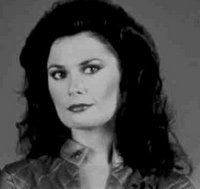 V, and V: The Series. Diana also commands a fleet of motherships. If we're fighting her, we can assume that she and her Visitor brethren want our resources (our water) and our very bodies (for food!) Diana is a scientist and military commander, and can't be trusted for a second. She also likes to eat large rodents. If we decide to play battleship brinkmanship with Diana, let's remember to beam over some "Red dust" to her command center.
V, and V: The Series. Diana also commands a fleet of motherships. If we're fighting her, we can assume that she and her Visitor brethren want our resources (our water) and our very bodies (for food!) Diana is a scientist and military commander, and can't be trusted for a second. She also likes to eat large rodents. If we decide to play battleship brinkmanship with Diana, let's remember to beam over some "Red dust" to her command center.Other options? Well, we could always fight Dragos, Jason's sworn enemy on Jason of Star Command, the follow-up to Space Academy. He's played by one of the Devil's Rejects, Sid Haig.

So who's it going to be? When you raise shields and arm photon torpedoes, who are you engaging in battle? The Dominion? The new Cylons from the "re-imagined" Battlestar? The Reavers on Firefly? Farscape's Peacekeepers? Or what about those body/organ-stealing aliens from Gerry Anderson's UFO?
Personally, I wouldn't choose the Borg, because they scare me too much, though they are perhaps the ultimate sci-fi villain.
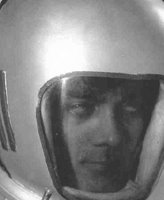 Instead, I'm leaning strongly towards Ardala. After a couple of volleys of phasers, I could beam over to her flagship for some one-on-one diplomacy, if you get my drift. And unlike Diana, I wouldn't end up served on a platter to a bunch of lizards...
Instead, I'm leaning strongly towards Ardala. After a couple of volleys of phasers, I could beam over to her flagship for some one-on-one diplomacy, if you get my drift. And unlike Diana, I wouldn't end up served on a platter to a bunch of lizards... award-winning creator of the web series Abnormal Fixation (2024), the audio drama Enter the House Between (2023) and author of 35 books including Horror Films FAQ (2013), Horror Films of the 1990s (2011), Horror Films of the 1980s (2007), TV Year (2007), The Rock and Roll Film Encyclopedia (2007), Mercy in Her Eyes: The Films of Mira Nair (2006),, Best in Show: The Films of Christopher Guest and Company (2004), The Unseen Force: The Films of Sam Raimi (2004), An Askew View: The Films of Kevin Smith (2002), The Encyclopedia of Superheroes on Film & Television (2004), Exploring Space:1999 (1997), An Analytical Guide to TV's Battlestar Galactica (1998), Terror Television (2001), Space:1999 - The Forsaken (2003) and Horror Films of the 1970s (2002).
award-winning creator of the web series Abnormal Fixation (2024), the audio drama Enter the House Between (2023) and author of 35 books including Horror Films FAQ (2013), Horror Films of the 1990s (2011), Horror Films of the 1980s (2007), TV Year (2007), The Rock and Roll Film Encyclopedia (2007), Mercy in Her Eyes: The Films of Mira Nair (2006),, Best in Show: The Films of Christopher Guest and Company (2004), The Unseen Force: The Films of Sam Raimi (2004), An Askew View: The Films of Kevin Smith (2002), The Encyclopedia of Superheroes on Film & Television (2004), Exploring Space:1999 (1997), An Analytical Guide to TV's Battlestar Galactica (1998), Terror Television (2001), Space:1999 - The Forsaken (2003) and Horror Films of the 1970s (2002).
Saturday, February 18, 2006
SATURDAY MORNING CULT TV BLOGGING: Space Academy: "Star Legend"
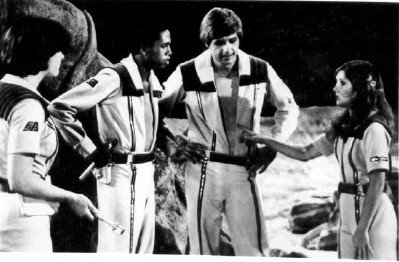
The Seeker is miraculously rescued by a "strange old-fashioned laser beam," which pushes the craft out of the futuristic Bermuda Triangle. On the viewscreen, a strange disembodied head appears and warns the Seeker to stay away.
Thus begins "Star Legend," written by Samuel Peeples and directed by Ezra Stone. Meanwhile, back at the Academy, Gampu comes to believe that the legendary Captain Rampo (Howard Morris), "the flying dutchman of outer space" may be responsible for the incident with the Seeker. Gampu describes the legend of how Rampo, captaining an early planetoid spacecraft not unlike the the Academy, became lost in space, over a millennium ago. Tee Gar then obligingly reports that a millennium is a thousand years. Thanks, Tee Gar! Anyway, Commander Gampu flies the Academy in (full speed ahead!) to the Alderaan Triangle's lateral perimeter, and the Academy too is promptly drained of energy...
With the Academy frozen in the Triangle, Gampu takes Blue Team aboard a Seeker to Rampo's space craft, which resembles the Academy, but is lit green. Once on board, a strange specter warns them to "leave...or stay forever" and states that "all visitors here are doomed...doomed!"
Gampu and his cadets laser down a locked door and discover 1,603 year-old Captain Rampo, a funny old man dressed like a train conductor, circa 1910. Turns out he's been pulling a Balok strategy (from the classic Star Trek episode, "The Corbomite maneuver.") A thousand years ago, he was establishing a colony on a nearby planet when the sun went nova. A magnetic storm forced him to cross into the Alderaan Triangle and he and his ship have remained trapped there, orbiting the space trap in an attempt to stop a "scourge of energy vapor" which drains ships of power. He's been pretending to be a fierce specter to keep other ships away...when in reality he's just a kindly old man. But unlike Balok, he doesn't offer anybody Tranya.
Gampu and the others decide to give the hungry energy vapor "indigestion." They lure it into the captain's quarters, then return to the Seeker and destroy Rampo's ship...thus ending the star legend.
"It's the end of an era," one character realizes a bit sadly. Yes, indeed it is, for this was my last episode of Space Academy! I've finished blogging about every episode. Hah! Camolopardis!
Next week, for Saturday Morning Cult TV blogging, I begin posting about episodes of another 1970s kid's show. Stay tuned. And pour the milk on the Cheerios.
 award-winning creator of the web series Abnormal Fixation (2024), the audio drama Enter the House Between (2023) and author of 35 books including Horror Films FAQ (2013), Horror Films of the 1990s (2011), Horror Films of the 1980s (2007), TV Year (2007), The Rock and Roll Film Encyclopedia (2007), Mercy in Her Eyes: The Films of Mira Nair (2006),, Best in Show: The Films of Christopher Guest and Company (2004), The Unseen Force: The Films of Sam Raimi (2004), An Askew View: The Films of Kevin Smith (2002), The Encyclopedia of Superheroes on Film & Television (2004), Exploring Space:1999 (1997), An Analytical Guide to TV's Battlestar Galactica (1998), Terror Television (2001), Space:1999 - The Forsaken (2003) and Horror Films of the 1970s (2002).
award-winning creator of the web series Abnormal Fixation (2024), the audio drama Enter the House Between (2023) and author of 35 books including Horror Films FAQ (2013), Horror Films of the 1990s (2011), Horror Films of the 1980s (2007), TV Year (2007), The Rock and Roll Film Encyclopedia (2007), Mercy in Her Eyes: The Films of Mira Nair (2006),, Best in Show: The Films of Christopher Guest and Company (2004), The Unseen Force: The Films of Sam Raimi (2004), An Askew View: The Films of Kevin Smith (2002), The Encyclopedia of Superheroes on Film & Television (2004), Exploring Space:1999 (1997), An Analytical Guide to TV's Battlestar Galactica (1998), Terror Television (2001), Space:1999 - The Forsaken (2003) and Horror Films of the 1970s (2002).
Friday, February 17, 2006
Guess The Movie # 4
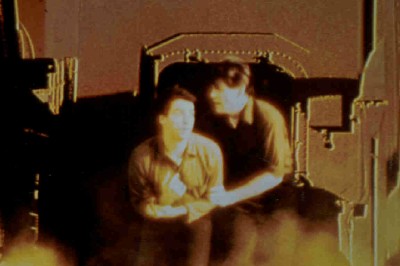
 award-winning creator of the web series Abnormal Fixation (2024), the audio drama Enter the House Between (2023) and author of 35 books including Horror Films FAQ (2013), Horror Films of the 1990s (2011), Horror Films of the 1980s (2007), TV Year (2007), The Rock and Roll Film Encyclopedia (2007), Mercy in Her Eyes: The Films of Mira Nair (2006),, Best in Show: The Films of Christopher Guest and Company (2004), The Unseen Force: The Films of Sam Raimi (2004), An Askew View: The Films of Kevin Smith (2002), The Encyclopedia of Superheroes on Film & Television (2004), Exploring Space:1999 (1997), An Analytical Guide to TV's Battlestar Galactica (1998), Terror Television (2001), Space:1999 - The Forsaken (2003) and Horror Films of the 1970s (2002).
award-winning creator of the web series Abnormal Fixation (2024), the audio drama Enter the House Between (2023) and author of 35 books including Horror Films FAQ (2013), Horror Films of the 1990s (2011), Horror Films of the 1980s (2007), TV Year (2007), The Rock and Roll Film Encyclopedia (2007), Mercy in Her Eyes: The Films of Mira Nair (2006),, Best in Show: The Films of Christopher Guest and Company (2004), The Unseen Force: The Films of Sam Raimi (2004), An Askew View: The Films of Kevin Smith (2002), The Encyclopedia of Superheroes on Film & Television (2004), Exploring Space:1999 (1997), An Analytical Guide to TV's Battlestar Galactica (1998), Terror Television (2001), Space:1999 - The Forsaken (2003) and Horror Films of the 1970s (2002).
TV REVIEW: Invasion: "The Nest"
The next generation of aliens in Homestead will soon arrive. Hopefully in time for a cliffhanger 'round about May?
All along, I believed the template for Invasion was Invasion of the Body Snatchers. Turns out I was wrong. It's Village of the Damned. Actually, I was delighted with this story development, because it's such a major turn - and such a big plot point. Now viewers have something to really anticipate...the birth of the first generation of hybrid children. Will they be more alien than human? Will they herald the end of the human race?
Written by Julie Siege and Shaun Cassidy and directed by Lawrence Trilling, Invasion's "The Nest" also features a major plot about Kira's disaffected teen rebellion. As the episode concludes, one of the orange sea creatures has taken her in the surf...and rejected her for the hybridization process. To me, this seemed like a bit of a cheat. The aliens should have taken Kira and changed her, just like they do everybody else, right?. I assume that in the weeks ahead, we'll discover why that wasn't the case. Does Kira possess some genetic abnormality that could be the key to preserving humanity? Could she inoculate the human race against the hybridization process? Tom Underlay has now said explicitly that she can't be changed like he was. Why? Did he make some kind of deal with the other aliens? We'll see...
Since 2006, Invasion has really taken off at warp speed. I don't know if it's desperation (given the mediocre ratings the series has drawn), or this was the plan all along, but now that Surface is gone, Invasion represents my weekly fix of science fiction drama/conspiracy. And it doesn't disappoint.
 award-winning creator of the web series Abnormal Fixation (2024), the audio drama Enter the House Between (2023) and author of 35 books including Horror Films FAQ (2013), Horror Films of the 1990s (2011), Horror Films of the 1980s (2007), TV Year (2007), The Rock and Roll Film Encyclopedia (2007), Mercy in Her Eyes: The Films of Mira Nair (2006),, Best in Show: The Films of Christopher Guest and Company (2004), The Unseen Force: The Films of Sam Raimi (2004), An Askew View: The Films of Kevin Smith (2002), The Encyclopedia of Superheroes on Film & Television (2004), Exploring Space:1999 (1997), An Analytical Guide to TV's Battlestar Galactica (1998), Terror Television (2001), Space:1999 - The Forsaken (2003) and Horror Films of the 1970s (2002).
award-winning creator of the web series Abnormal Fixation (2024), the audio drama Enter the House Between (2023) and author of 35 books including Horror Films FAQ (2013), Horror Films of the 1990s (2011), Horror Films of the 1980s (2007), TV Year (2007), The Rock and Roll Film Encyclopedia (2007), Mercy in Her Eyes: The Films of Mira Nair (2006),, Best in Show: The Films of Christopher Guest and Company (2004), The Unseen Force: The Films of Sam Raimi (2004), An Askew View: The Films of Kevin Smith (2002), The Encyclopedia of Superheroes on Film & Television (2004), Exploring Space:1999 (1997), An Analytical Guide to TV's Battlestar Galactica (1998), Terror Television (2001), Space:1999 - The Forsaken (2003) and Horror Films of the 1970s (2002).
TV REVIEW: Lost: "One of Them"
Good thing I taped the episode, titled "One of Them," and authored by Carlton Cuse and Damon Lindelof. This episode brought back the crazy French lady, Rousseau (Mira Furlan) and she's been busy. Specifically, she netted herself a stranger in the forest, and then went to Sayid to help with finding out his identity. The interloper claims to be a widower from Minnesota who ballooned to the island and has been there for four months.
This tale didn't pass the smell test for Sayid, and - boom - we're off to the flashback derby as the former Republican Guard soldier remembers his "first time" as a torturer in the 1991 Gulf War. I've ragged on Surface for the lousy CGI it deploys, so fair is fair: the CG depictions of Iraq on Lost were unbelievably lousy. I lost track of the plot for a minute, gaping at the cartoony effects. Damn! This is like the most successful show on television, and it can't afford some decent CG? Time to kill off another character (and save some money on actors), then!
Meanwhile, in the present, Jack and Locke continue to battle over the "button." This reminds me of a Get Smart story I remember. Operation "Button, Button-Who-Will-Press-The-Button." Ultimately, nobody hits the button and some weird ass red and black tiles with impenetrable symbols appear briefly on the clock tiles. Then the button re-set, and my wife concluded that Locke must have hit ctrl-alt-delete. Whatever. Once again on Lost: a lot of build-up and suspense leading to...a total and complete cheat and non-answer.
At least this week, Sayid actually addressed some of the oddities on the island with another castaway (Charlie). To paraphrase, he asks if anybody remembers that Claire was abducted. Or that the Others can come and take them at any moment. Good questions, buddy. Cuz watching Lost these days, I'm thinking it's all about chasing tree frogs and eating ranch dressing.
We got about twenty minutes of new story in "One of Them." Which is better than the average lately. As far as the flashbacks...well, we already knew that Sayid was a torturer, didn't we? As I wrote last week, unless the point of this show is that the island is Purgatory and the flashbacks represent the characters grappling with their considerable sins, the flashbacks now serve no purpose dramatically. Except...to...slow...down...the....real...story...
And yet I tune in every single week, ready for more clue crumbs. May I have some more, sir? Please?
 award-winning creator of the web series Abnormal Fixation (2024), the audio drama Enter the House Between (2023) and author of 35 books including Horror Films FAQ (2013), Horror Films of the 1990s (2011), Horror Films of the 1980s (2007), TV Year (2007), The Rock and Roll Film Encyclopedia (2007), Mercy in Her Eyes: The Films of Mira Nair (2006),, Best in Show: The Films of Christopher Guest and Company (2004), The Unseen Force: The Films of Sam Raimi (2004), An Askew View: The Films of Kevin Smith (2002), The Encyclopedia of Superheroes on Film & Television (2004), Exploring Space:1999 (1997), An Analytical Guide to TV's Battlestar Galactica (1998), Terror Television (2001), Space:1999 - The Forsaken (2003) and Horror Films of the 1970s (2002).
award-winning creator of the web series Abnormal Fixation (2024), the audio drama Enter the House Between (2023) and author of 35 books including Horror Films FAQ (2013), Horror Films of the 1990s (2011), Horror Films of the 1980s (2007), TV Year (2007), The Rock and Roll Film Encyclopedia (2007), Mercy in Her Eyes: The Films of Mira Nair (2006),, Best in Show: The Films of Christopher Guest and Company (2004), The Unseen Force: The Films of Sam Raimi (2004), An Askew View: The Films of Kevin Smith (2002), The Encyclopedia of Superheroes on Film & Television (2004), Exploring Space:1999 (1997), An Analytical Guide to TV's Battlestar Galactica (1998), Terror Television (2001), Space:1999 - The Forsaken (2003) and Horror Films of the 1970s (2002).
Thursday, February 16, 2006
RETRO TOY FLASHBACK #30: Sci-Fi Magazines!
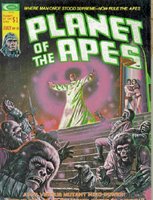 I don't know if this is a statement on literacy in our times or what, but I grew up with a passionate love for each and every magazine on the market that featured science fiction or horror films, or TV shows, for that matter. So I decided it would be an appropriate topic for this "retro" Thursday (even though magazines - like record albums - aren't technically toys.)
I don't know if this is a statement on literacy in our times or what, but I grew up with a passionate love for each and every magazine on the market that featured science fiction or horror films, or TV shows, for that matter. So I decided it would be an appropriate topic for this "retro" Thursday (even though magazines - like record albums - aren't technically toys.)I know that many, many dedicated horror fans (and some movie directors too... ) started their love of genre 'mags over the years with Mr. Ackerman's Famous Monsters - but for me...my gateway periodical was actually Marvel's Planet of the Apes.
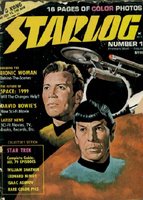 This great magazine (published in the mid 1970s) was really the best of both worlds for the young, book-nerd and intrepid Ape-o-naut. At either end of each issue was a beautifully-drawn comic book story, often an adaptation of a particular Apes film or part of an ongoing serial called Terror on the Planet of the Apes.
This great magazine (published in the mid 1970s) was really the best of both worlds for the young, book-nerd and intrepid Ape-o-naut. At either end of each issue was a beautifully-drawn comic book story, often an adaptation of a particular Apes film or part of an ongoing serial called Terror on the Planet of the Apes.However, sandwiched in between these comic tales of simian domination were articles all about the cinematic world of Planet of the Apes. For instance, there was on issue boasting a photo spread of the impressive Ape City, which was incredibly cool. Other times, there were interviews with writers like Michael Wilson, behind-the-scenes stories about make-up and special effects, and even a feature on the Fox Ranch, where the movies were filmed.

I first discovered these magazines 'round about 1978, I'd guess, when I was a huge Apes fan. (I already owned many playsets and action figures from Mego...). Where did I buy the magazine? There was this little cramped store inside a warehouse-like building at Englishtown Flea Market, in New Jersey. And - I kid you not - the entire place consisted of floor-to-ceiling shelving loaded with comics and magazines of all varieties. It was simply amazing, and it was my first experience with a "comic book" shop. I purchased these Planet of the Apes magazines religiously (and they were like a buck a piece!).
From there, my love of Starlog developed. There was a vendor at Englishtown who sold these magazines as well. The mags
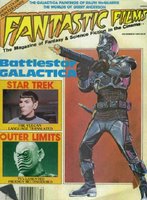 were pinned up high by clips(near the ceiling...) along a big center aisle in the same building as the little comic shop.
were pinned up high by clips(near the ceiling...) along a big center aisle in the same building as the little comic shop.If memory serves, I believe I started my Starlog obsession around 1980, the year of The Empire Strikes Back, so my first task was catching up on all the back-issues of the magazine. Do you remember how Starlog used to abbreviate all its movie and TV titles? I still hold those funny abbreviations in my brain. Close Encounters was CE3K. Lost in Space was LIS. Star Trek: The Motion Picture was ST: TMP. The Greatest American Hero was GAH. Anyone else remember that weird little tic in those long ago days?
I also remember how excited I was when I finally found the
 Starlog issue (#33) that featured all the reviews (including Harlan Ellison's and David Gerrold's) of Star Trek: the Motion Picture....which was something of an obsession with me.
Starlog issue (#33) that featured all the reviews (including Harlan Ellison's and David Gerrold's) of Star Trek: the Motion Picture....which was something of an obsession with me.In years to come, I came to realize that Starlog (of those days, anyway) had a distinct bias against certain shows (particularly Space:1999), and that was a bummer, but it was just fascinating to me a as a kid to read about movies in development, and pore over interviews with Han Solo (Harrison Ford) and memorize things like episode guides of Lost in Space or The Twilight Zone. I still have deep affection for Starlog, though I probably haven't purchased a new issue in years. My collection goes from 1 - 263, and then I stopped.
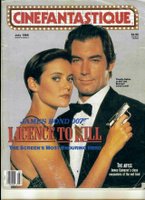
I also happened to love another genre magazine that was published at the ssame time, but died in the mid-1980s: Fantastic Films. I remember reading with enthusiasm about upcoming TV shows like Automan and movies such as Star Trek III: The Search for Spock, on one cross-country trip with my family. Those were the days....
Later on, in high school, I discovered Fangoria, and became a regular reader of that gory magazine (as well as the companion, Gorezone), even though some of the photo spreads really grossed me out. I liked the book and video reviews in Fangoria, as well as reports on what favorites like Sam Raimi, Wes Craven, John Carpenter and Tobe Hooper were
 doing through the late 1980s. It's funny, I remember that for a spell back in the Reagan decade, Freddy Krueger was so popular that virtually every Fangoria issue would feature a cover headline about a "new" icon who was about to unseat him. One was the ghoul of I, Madman (1989). And another was Richard Lynch, the guru of Unity Fields from Bad Dreams (1988). Anyone remember him?
doing through the late 1980s. It's funny, I remember that for a spell back in the Reagan decade, Freddy Krueger was so popular that virtually every Fangoria issue would feature a cover headline about a "new" icon who was about to unseat him. One was the ghoul of I, Madman (1989). And another was Richard Lynch, the guru of Unity Fields from Bad Dreams (1988). Anyone remember him?The summer I was sixteen, my Dad took me out to get my working papers and Social Security card, and I quickly got a job working the morning shift at a local McDonalds Restaurant in Bloomfield, N.J. I worked every morning from 5:00 am to 11:00 am, and was an expert at making Egg McMuffins. I was working to make "living" money for college, and so I saved every single dollar I earned. But my parents literally made me spend some money on
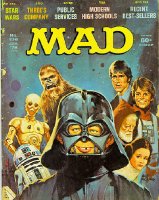 some fun things. I'm not kidding, they'd drive me to a used book and comic store in Passaic and forced me to buy entertainment-y things. That's cool, and guess what I chose to buy? Magazines! The late 1980s was a great time for magazine start-ups and I remember slurping up all the issues of an obscure magazine called Daredevils. Has anybody ever heard of this periodical? It was a great magazine that had a focus on classic movie actors (like Humphrey Bogart and Charlie Bronson), as well as James Bond movies and spy TV shows. But I think it folded rather quickly.
some fun things. I'm not kidding, they'd drive me to a used book and comic store in Passaic and forced me to buy entertainment-y things. That's cool, and guess what I chose to buy? Magazines! The late 1980s was a great time for magazine start-ups and I remember slurping up all the issues of an obscure magazine called Daredevils. Has anybody ever heard of this periodical? It was a great magazine that had a focus on classic movie actors (like Humphrey Bogart and Charlie Bronson), as well as James Bond movies and spy TV shows. But I think it folded rather quickly.When I went away to college, I continued my habit of collecting sci-fi magazines. I lived on campus at the University of
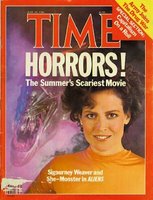 Richmond (in Robins Hall), and I would walk through a leaf-laden field, over a wood bridge, through a housing development, up a steep hill, across a highway to a comic book store called Dave's Comics. It was there that I was able to catch up on Cinefantastique. I rabidly collected this magazine through the 1980s and 1990s and was always impressed by the breadth of its genre coverage. I'll never forget collecting this magazine during the run of The Next Generation and Deep Space Nine, and I looked forward to the big issues that featured season reviews, replete with episode guides and extensive interviews. This was just a terrific reading experience.
Richmond (in Robins Hall), and I would walk through a leaf-laden field, over a wood bridge, through a housing development, up a steep hill, across a highway to a comic book store called Dave's Comics. It was there that I was able to catch up on Cinefantastique. I rabidly collected this magazine through the 1980s and 1990s and was always impressed by the breadth of its genre coverage. I'll never forget collecting this magazine during the run of The Next Generation and Deep Space Nine, and I looked forward to the big issues that featured season reviews, replete with episode guides and extensive interviews. This was just a terrific reading experience.It was also at Dave's Comics that I discovered another
 short-lived magazine that I fell in love with, one from the early 1990s called Epi-Log. Edited by William Anchors, this attractive magazine featured tons of detailed episode guides every month, and the editors even did theme issues, like horror, superheroes, spies, space adventure and the like. I should also add that although the photos were always in black-and-white, they were often rare, unusual shots, and I grooved on that.
short-lived magazine that I fell in love with, one from the early 1990s called Epi-Log. Edited by William Anchors, this attractive magazine featured tons of detailed episode guides every month, and the editors even did theme issues, like horror, superheroes, spies, space adventure and the like. I should also add that although the photos were always in black-and-white, they were often rare, unusual shots, and I grooved on that.Basically, I collect any magazines with science fiction covers gracing them. This means that I got my hands on a Mad Magazine with a Star Wars parody cover from 1977. This means that I would collect Time Magazine if it featured Star Wars, Star Trek, or Aliens.
 Also - I cannot tell a lie - for a while in the 1980s I collected Playboy Magazine. For the articles, dude. For the articles. My favorite issue is the one displayed here on the blog...featuring Maryam D'Abo from The Living Daylights. There's a shot of this lovely actress riding the hood of Bond's car from Goldfinger...nude. There's another where she's cradling Blofeld's...kitty. You have not truly lived until you've seen these photographs.
Also - I cannot tell a lie - for a while in the 1980s I collected Playboy Magazine. For the articles, dude. For the articles. My favorite issue is the one displayed here on the blog...featuring Maryam D'Abo from The Living Daylights. There's a shot of this lovely actress riding the hood of Bond's car from Goldfinger...nude. There's another where she's cradling Blofeld's...kitty. You have not truly lived until you've seen these photographs.I never imagined while collecting magazines as a kid, a teenager and a young adult that I would some day see my own books reviewed in these magazines (Fangoria, Filmfax, Sci-Fi Magazine), or that I would write articles for them myself (Filmfax, Cinescape, The Official Farscape Magazine). It's funny how life turns out sometimes, isn't it?
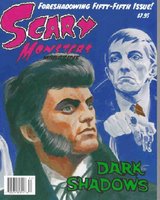
So...did you ever collect sci-fi and horror magazines? And if so, which ones are your favorites? Around Halloween last year, I finally had to purchase a huge filing cabinet for my office to maintain my collection.
Yep, these magazines are not only fun, they come in handy as research on my books. In fact, I wonder if my subscriptions are tax deductible?
 award-winning creator of the web series Abnormal Fixation (2024), the audio drama Enter the House Between (2023) and author of 35 books including Horror Films FAQ (2013), Horror Films of the 1990s (2011), Horror Films of the 1980s (2007), TV Year (2007), The Rock and Roll Film Encyclopedia (2007), Mercy in Her Eyes: The Films of Mira Nair (2006),, Best in Show: The Films of Christopher Guest and Company (2004), The Unseen Force: The Films of Sam Raimi (2004), An Askew View: The Films of Kevin Smith (2002), The Encyclopedia of Superheroes on Film & Television (2004), Exploring Space:1999 (1997), An Analytical Guide to TV's Battlestar Galactica (1998), Terror Television (2001), Space:1999 - The Forsaken (2003) and Horror Films of the 1970s (2002).
award-winning creator of the web series Abnormal Fixation (2024), the audio drama Enter the House Between (2023) and author of 35 books including Horror Films FAQ (2013), Horror Films of the 1990s (2011), Horror Films of the 1980s (2007), TV Year (2007), The Rock and Roll Film Encyclopedia (2007), Mercy in Her Eyes: The Films of Mira Nair (2006),, Best in Show: The Films of Christopher Guest and Company (2004), The Unseen Force: The Films of Sam Raimi (2004), An Askew View: The Films of Kevin Smith (2002), The Encyclopedia of Superheroes on Film & Television (2004), Exploring Space:1999 (1997), An Analytical Guide to TV's Battlestar Galactica (1998), Terror Television (2001), Space:1999 - The Forsaken (2003) and Horror Films of the 1970s (2002).
Guest Post: The Monkey (2025)
The Monkey By Jonas Schwartz-Owen The Monkey , based on a Stephen King short story, is more an exercise than a movie. Death becomes so triv...

-
Last year at around this time (or a month earlier, perhaps), I posted galleries of cinematic and TV spaceships from the 1970s, 1980s, 1...
-
The robots of the 1950s cinema were generally imposing, huge, terrifying, and of humanoid build. If you encountered these metal men,...

